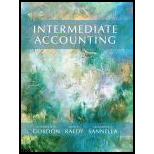
Intermediate Accounting
1st Edition
ISBN: 9780132162302
Author: Elizabeth A. Gordon, Jana S. Raedy, Alexander J. Sannella
Publisher: PEARSON
expand_more
expand_more
format_list_bulleted
Question
Chapter 14, Problem 14.15Q
To determine
To explain: Whether a company elects the fair value option for long-term liabilities and if it can report the unrealized gains and losses in other comprehensive income.
Expert Solution & Answer
Want to see the full answer?
Check out a sample textbook solution
Students have asked these similar questions
Multiple Choice 2-32
Educational Incentives (LO 2.14)
Wendy is a single taxpayer and pays tuition of $7,800 in 2021. Her 2021 AGI is $66,000. What is the amount of Wendy's tuition deduction?
X a. $2,000
O b. $0
O c. $3,733.33
O d. $4,000
O e. $7,800
Multiple Choice 2-32
Educational Incentives (LO 2.14)
Wendy is a single taxpayer and pays tuition of $7,800 in 2021. Her 2021 AGI is $66,000. What is the amount of Wendy's tuition deduction?
X a. $2,000
O b. $0
O c. $3,733.33
O d. $4,000
O e. $7,800
None
Chapter 14 Solutions
Intermediate Accounting
Ch. 14 - What conditions or terms does a note payable...Ch. 14 - If the market rate of interest exceeds the face or...Ch. 14 - What is included in bond issue costs and how...Ch. 14 - Prob. 14.4QCh. 14 - When a bond is issued at a discount, will its...Ch. 14 - Prob. 14.6QCh. 14 - Prob. 14.7QCh. 14 - Under IFRS, how do firms account for convertible...Ch. 14 - Prob. 14.9QCh. 14 - Can companies reclassify short-term debt expected...
Ch. 14 - Under IFRS, can companies reclassify short-term...Ch. 14 - Do companies always reclassify long-term debt that...Ch. 14 - Prob. 14.13QCh. 14 - Prob. 14.14QCh. 14 - Prob. 14.15QCh. 14 - Prob. 14.16QCh. 14 - Prob. 14.1MCCh. 14 - Prob. 14.2MCCh. 14 - Prob. 14.3MCCh. 14 - Prob. 14.4MCCh. 14 - Prob. 14.5MCCh. 14 - Clothes Horse Corp. (CHC) Issued 500,000 bonds due...Ch. 14 - Prob. 14.7MCCh. 14 - Prob. 14.8MCCh. 14 - Prob. 14.9MCCh. 14 - Prob. 14.10MCCh. 14 - Prob. 14.11MCCh. 14 - Prob. 14.1BECh. 14 - Notes Payable. Using the information provided in...Ch. 14 - Prob. 14.3BECh. 14 - Prob. 14.4BECh. 14 - Prob. 14.5BECh. 14 - Prob. 14.6BECh. 14 - Prob. 14.7BECh. 14 - Bond Pricing. Fill in the missing items for each...Ch. 14 - Prob. 14.9BECh. 14 - Bond Issue Price. Using the information from...Ch. 14 - Prob. 14.11BECh. 14 - Prob. 14.12BECh. 14 - Prob. 14.13BECh. 14 - Prob. 14.14BECh. 14 - Prob. 14.15BECh. 14 - Prob. 14.16BECh. 14 - Prob. 14.17BECh. 14 - Prob. 14.18BECh. 14 - Prob. 14.19BECh. 14 - Prob. 14.20BECh. 14 - Bonds Issued between Interest Payment Dates. For...Ch. 14 - Prob. 14.22BECh. 14 - Prob. 14.23BECh. 14 - Prob. 14.24BECh. 14 - Prob. 14.25BECh. 14 - Prob. 14.26BECh. 14 - Prob. 14.27BECh. 14 - Prob. 14.28BECh. 14 - Prob. 14.29BECh. 14 - Prob. 14.30BECh. 14 - Prob. 14.31BECh. 14 - Prob. 14.32BECh. 14 - Short-Term Debt Expected to Be Refinanced, IFRS....Ch. 14 - Prob. 14.34BECh. 14 - Prob. 14.35BECh. 14 - Prob. 14.36BECh. 14 - Prob. 14.37BECh. 14 - Prob. 14.38BECh. 14 - Prob. 14.39BECh. 14 - Prob. 14.1ECh. 14 - Prob. 14.2ECh. 14 - Prob. 14.3ECh. 14 - Prob. 14.4ECh. 14 - Prob. 14.5ECh. 14 - Prob. 14.6ECh. 14 - Prob. 14.7ECh. 14 - Prob. 14.8ECh. 14 - Prob. 14.9ECh. 14 - Prob. 14.10ECh. 14 - Prob. 14.11ECh. 14 - Prob. 14.12ECh. 14 - Prob. 14.13ECh. 14 - Prob. 14.14ECh. 14 - Prob. 14.15ECh. 14 - Prob. 14.16ECh. 14 - Prob. 14.17ECh. 14 - Prob. 14.18ECh. 14 - Prob. 14.19ECh. 14 - Prob. 14.20ECh. 14 - Prob. 14.21ECh. 14 - Prob. 14.1PCh. 14 - Prob. 14.2PCh. 14 - Prob. 14.3PCh. 14 - Prob. 14.4PCh. 14 - Prob. 14.5PCh. 14 - Prob. 14.6PCh. 14 - Prob. 14.7PCh. 14 - Prob. 14.8PCh. 14 - Prob. 14.9PCh. 14 - Prob. 14.10PCh. 14 - Prob. 1JCCh. 14 - Prob. 2JCCh. 14 - Prob. 3JCCh. 14 - Prob. 1FSACCh. 14 - Prob. 1SSCCh. 14 - Surfing the Standards Case 2: Bonds with...Ch. 14 - Prob. 1BCC
Knowledge Booster
Similar questions
arrow_back_ios
SEE MORE QUESTIONS
arrow_forward_ios
Recommended textbooks for you
 Cornerstones of Financial AccountingAccountingISBN:9781337690881Author:Jay Rich, Jeff JonesPublisher:Cengage Learning
Cornerstones of Financial AccountingAccountingISBN:9781337690881Author:Jay Rich, Jeff JonesPublisher:Cengage Learning College Accounting, Chapters 1-27AccountingISBN:9781337794756Author:HEINTZ, James A.Publisher:Cengage Learning,
College Accounting, Chapters 1-27AccountingISBN:9781337794756Author:HEINTZ, James A.Publisher:Cengage Learning,

Cornerstones of Financial Accounting
Accounting
ISBN:9781337690881
Author:Jay Rich, Jeff Jones
Publisher:Cengage Learning

College Accounting, Chapters 1-27
Accounting
ISBN:9781337794756
Author:HEINTZ, James A.
Publisher:Cengage Learning,

